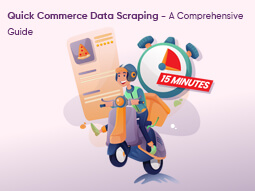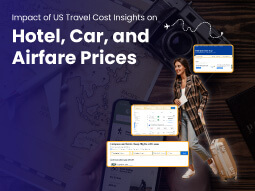Quick Commerce Data Scraping - A Comprehensive Guide
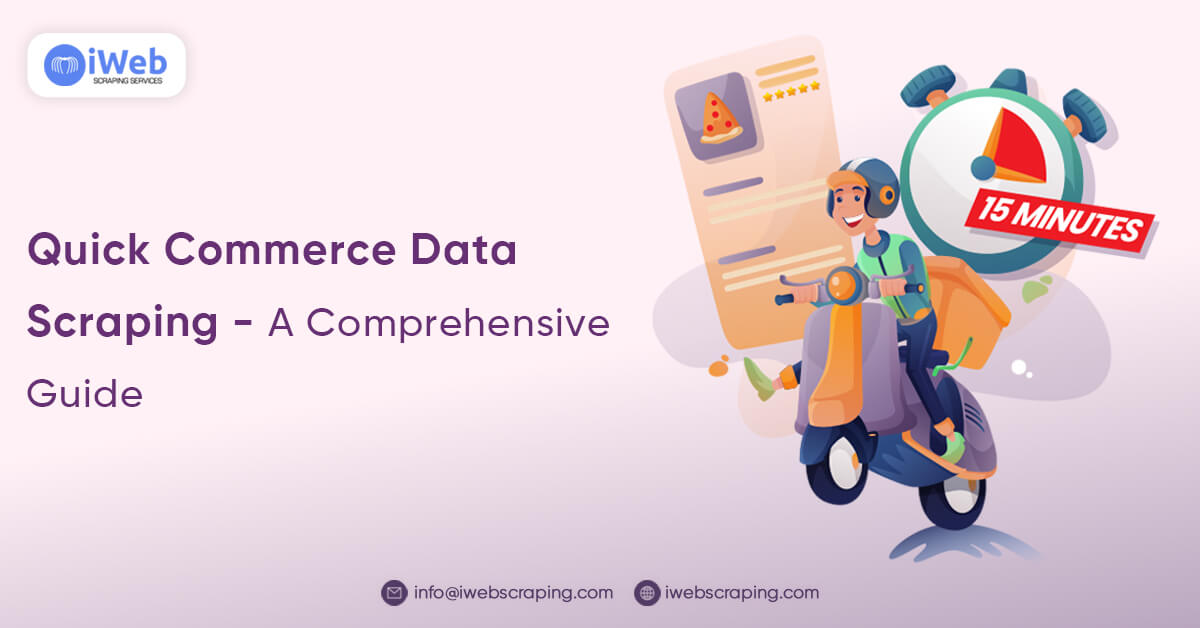
Overview of Quick Commerce
The more recent form of e-commerce is known as Quick Commerce or Q-Commerce. This form emphasizes the immediate delivery of products within about 10–30 minutes of the order being placed. This is due to the rising consumer trend of convenience and precisely what people need and want at their disposal, including groceries, snacks, medicines, and home appliances. In contrast with the general e-commerce concept that serves a larger number of customers, where deliverance happens over hours or days, Q-commerce focuses on small orders and delivery.
At the core of Quick commerce is the use of micro fulfillment centers, or so-called “dark stores,” located in densely populated urban areas. Such narrow stock houses contain smaller inventories but an assortment of items that meet high consumer traffic for quick order processing. Sophisticated logistics, effective route planner algorithms, and freelance delivery corps help make last-mile delivery prompt and efficient, allowing customers to get their orders in minutes.
The key Features of Quick Commerce are as follows
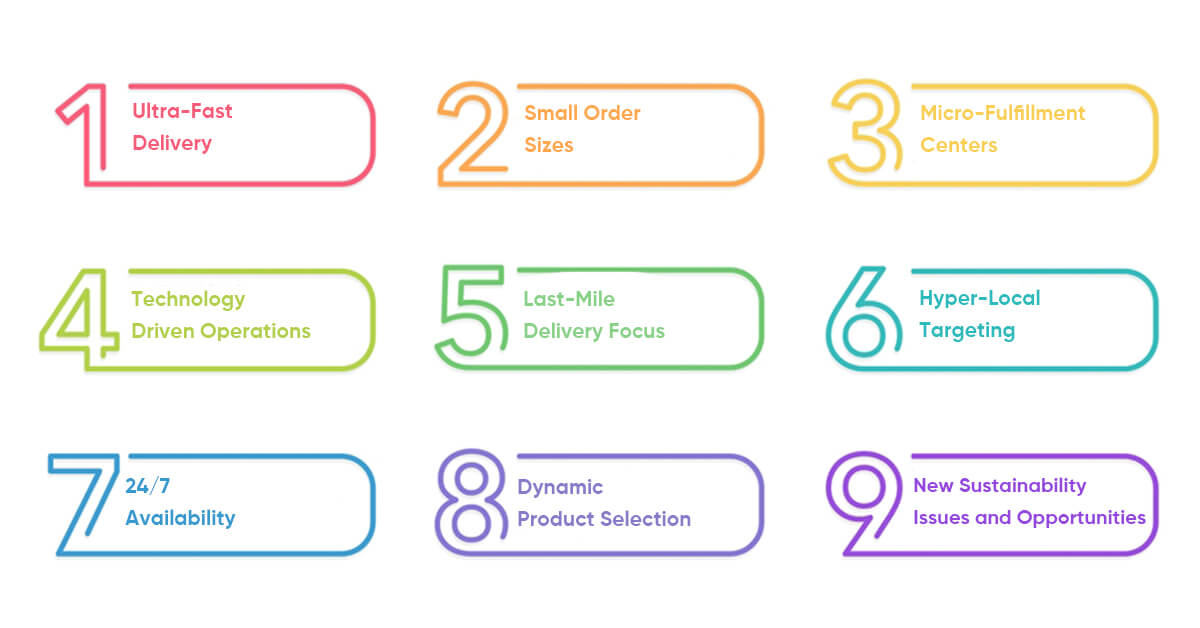
E-commerce has become the new norm for the shopping experience because it offers various benefits, such as fast delivery. However, such convenience comes with a price.
Ultra-Fast Delivery
Quick Commerce delivers orders within 10–30 minutes. It stands out from traditional e-shops because it targets consumers who require orders to be picked up quickly, such as food, sweets, and necessary supplies.
Small Order Sizes
While transactional e-commerce entails placing large orders for multiple products, most transactions involve a few popular products. It is a solution for daily focusing on the population's most pressing needs.
Micro-Fulfillment Centers
These are small depots or shops in urban centers called ‘dark stores.’ They stock only high-demand business items to ensure orders are quickly prepared and shipped.
Technology-Driven Operations
The Q-commerce platforms use AI, real-time data analytics, and route optimization to manage inventories and deliver the maximum possible orders. The primary mode of customer interaction is mobile applications with easily navigable interfaces.
Last-Mile Delivery Focus
Last-mile delivery encompasses the collection and delivery of orders, made possible by a strong logistics network and third-party contractors, such as gig workers.
Hyper-Local Targeting
Q-commerce also covers small delivery areas, preferably several kilometers around the fulfillment center, to ensure speedy delivery.
24/7 Availability
Most Quick Commerce services are available anytime, making it possible for consumers to purchase and receive their goods anytime.
Dynamic Product Selection
Demand patterns mean that high-demand products are stored as inventory spaces, while unused spaces are not wasted storing slow-moving products.
New Sustainability Issues and Opportunities
Despite the shortcomings of implementing Q-commerce, specifically the frequent delivery of small parcels, which negatively impacts the environment, firms are considering how to mitigate this through matters such as packaging and delivery vehicles to be environmentally friendly.
What are the Benefits of Quick Commerce?
Quick commerce technology helps customers fulfill their cravings and get their orders on time. Let’s explore diverse benefits in detail:
For Consumers
Convenience and Speed of Delivery
Quick Commerce is characterized by unexceptional services, delivering goods within an hour or even minutes. Customers can access stores online to fulfill necessities, including food, drugs, and other daily commodities. These needs require consumer attention and can be met in stores. This rapid service is invaluable if a significant demand or an organization runs out of stock.
Enhanced Shopping Experience
Quick Commerce made it easy for the client and boosted satisfaction. Ordering is a breeze, and delivery is on time and stress-free. This convenience makes it easier for customers to trust the service being offered by the service provider.
Access to a Broader Product Range
Having connected with multiple stores and suppliers, Quick Commerce platforms enable the delivery of a vast multitude of products for consumers’s needs, from perishable foods to household appliances. The nature of variety and speed sets these platforms apart from going to stores or malls.
For Businesses
Increased Sales and Revenue Opportunities
Quick Commerce increases customer attraction and purchase frequency by making the delivery more immediate to satisfy this demand. The model benefits impulse and low involvement products and frequently purchased product categories, providing sales and revenue advantage.
Improved Customer Satisfaction and Loyalty
Filling the modern consumer's expectation of speed and convenience improves business satisfaction. Satisfied customers are likely to return in the future and recommend other customers purchase the same product, creating a lasting customer base.
Enhanced Operational Efficiency and Competitiveness
Quick Commerce forces organizations to adapt to new delivery models that help them provide consumers with faster delivery, better inventory control, and less product waste. This is cost-effective and strategically positions these firms at the forefront of a constantly transforming retail market, creating a competitive advantage for whoever adopts the idea.
Challenges in Quick Commerce Data Scraping
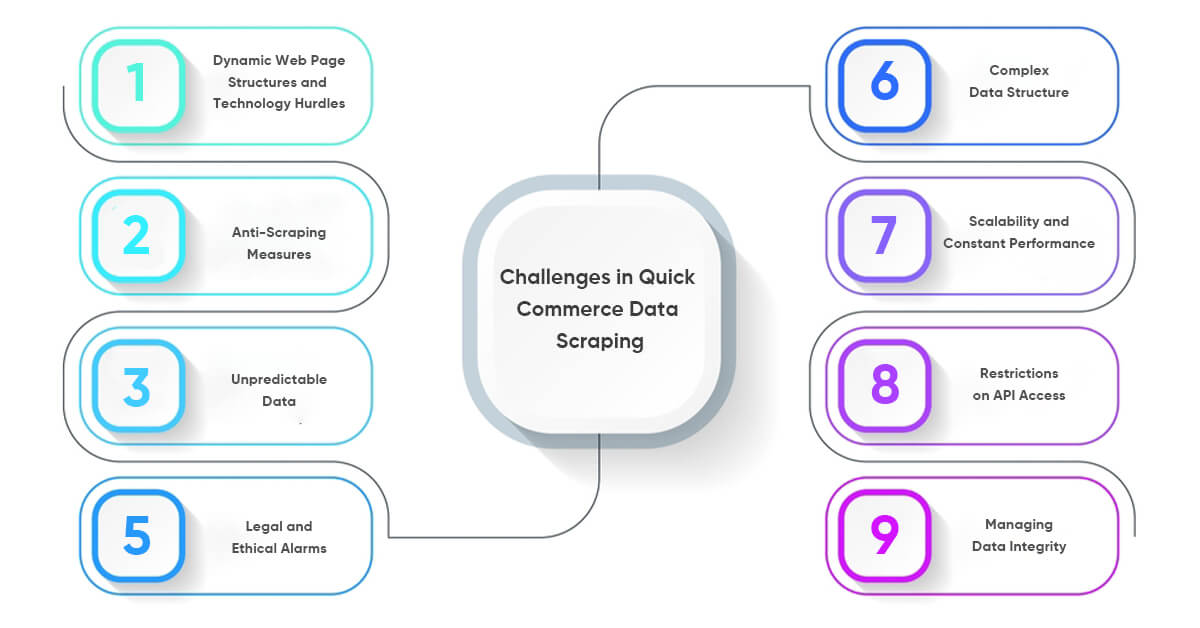
Some of the challenges quick commerce platforms face include high operating expenses, sustainability issues, and low profit margins. However, the sector recognized high growth potential, such as using artificial intelligence in inventory management, automated product delivery, and product diversity, which is not limited to food staples.
Dynamic Web Page Structures and Technology Hurdles
As technology emerges, Q-commerce platforms adopt modern ways to represent and safeguard data. However, using cutting-edge technologies can be a significant hurdle when scraping data.
JavaScript-Based Content: Q-commerce websites use JavaScrpit-based technologies such as React, Angular, Vue, etc., to serve the content dynamically. Scraping content from these pages required advanced data extraction tools.
Long Scroll and Lazy Loading: Product category pages are becoming longer as more products are available. Platforms use lazy loading techniques to overcome page loading issues and improve speed.
Page Updates: To match the competition and provide a unique experience to users, platforms frequently change the UI/UX of the pages
Anti-Scraping Measures
Use of CAPTCHAs: Domains use CAPTCHAs to restrict the bots and spamming activities.
Rate Limitation: Rate limitations make identifying unusual traffic and requests easy if they exceed the pre-defined thresholds.
IP Block: Getting multiple requests from the same IP again and again can result in IP blocking
Behavioral Analysis: Advanced algorithms analyze request behavior patterns. This helps businesses easily identify bots, as programs are more complex than humans.
Unpredictable Data
Dynamic Product Prices: Sellers quickly change product prices to accommodate demands, inventory, promotions, discounts, etc. Real-time price capture is mandatory to ensure accurate prices.
Stock Readiness: During festivals and peak seasons, stock frequently runs out. Data scraping tools must easily manage the fluctuation in inventory levels.
Local Data: Q-commerce domains mainly offer deals, prices, delivery services, and more, keeping the service region in mind. Location-based data scraping techniques are essential.
Legal and Ethical Alarms
Violation of Platform Terms: Most domains do not allow data extractions, as mentioned in their platform’s terms of service. Failure to comply can result in legal action.
Data Privacy and Security Regulations: Data protection rules such as GDPR, Cothers, and Do More do not allow data scraping. Extracting and using personal data can cause huge trouble.
Use of Data: It is also essential to examine how scrapped data is utilized. Unethical data use can lead to trouble.
Complex Data Structure
Compound Product Categories: Nowadays, platforms use a complex data structure to showcase products in multiple categories. Recursive data extraction is needed to crawl and scrape data from the entire structure.
Metadata: Getting multiple product details requires data scrapers that can manage diverse and rich data formats.
Multimedia Data: Scraping high–quality images, videos, advanced product previews, and other high-resolution graphics requires considerable effort.
Scalability and Constant Performance
Distributed Data Scraping: To scrape huge datasets and manage rate limits, distributed data extraction, and proxy usage are required.
Real-Time Data Extraction: Real-time data scraping is essential for obtaining reliable data. It requires robust infrastructure and advanced systems.
Managing Errors: Scrapers and APIs must be able to manage dynamic errors at any time with minimal human interaction.
Restrictions on API Access
API Restrictions: APIs require authentication to access data. E-commerce platforms tend to limit access to authorized users only.
Rate Limiting: Using rate limitations makes things difficult for the APIs while scraping the data.
Incomplete Data: Extracted data from APIs may be incomplete. Combining API and web scraping techniques can help here.
Managing Data Integrity
Data Duplication: Data extracted from multiple sources may have duplicate values. This needs to be cleaned before the retrieved data is used for analysis.
Data Mapping: Matching the product information can be complicated, as data gathered from various domains contains different names, details, and categories for the same products.
Timeliness: In the competitive era, it is essential to keep the data current to match the market's competition.
How to Address the Q-commerce Data Scraping Challenges
Use of Advanced Scraping Tools and Technologies
Advanced tools such as Puppeteer, Selenium, or Playwright help easily extract JavaScript-based content. The APIs can be scaled to access structured data directly without technical glitches. The advanced script can also manage long scrolls and lazy load content.
Avoid Anti-Scraping Measures
To manage data scraping restrictions, use residential proxies along with rotating IPs. This will help you stay undetected and avoid a ban. Get CAPTCHA-solving services to easily avoid CAPTCHA restrictions and represent bots as humans. Rotate user agents and maintain cookies to establish scrapers as real humans accessing the information. Distributed data scraping can be an effective strategy for making the data extraction task very easy.
Avoid Anti-Scraping Measures
To manage data scraping restrictions, use residential proxies along with rotating IPs. This will help you stay undetected and avoid a ban. Get CAPTCHA-solving services to easily avoid CAPTCHA restrictions and represent bots as humans. Rotate user agents and maintain cookies to establish scrapers as real humans accessing the information. Distributed data scraping can be an effective strategy for making the data extraction task very easy.
Address Legal and Ethical Issues
Go through the terms of services before scraping the data from any platform to know their policies and mitigate the risk of a legal violation. Check the robots.txt file to find out which page you can scrape the data with permission from the domain. It is advisable to consult with legal experts before starting the data scraping procedure to be safe from regulations such as GDPR, CCPA, or other privacy regulations.
Conclusion
After reading the above blog, data is inevitable for any Q-commerce business. It helps to make important business decisions, optimize services, and satisfy customer needs. Scraping Q-commerce data helps brands monitor competitors and gain an edge through effective market analysis and accurate future predictions.
Q-commerce data scraping has specific challenges. Addressing those challenges ethically makes the data extraction process smooth. To mitigate these obstacles, businesses must make thoughtful plans, use advanced tools, and invest in the right technologies.


